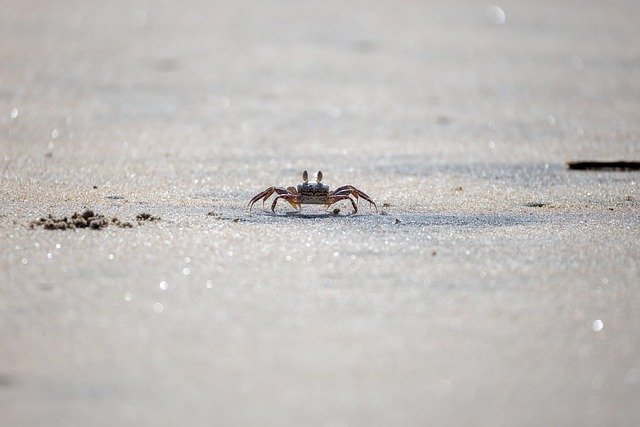Decoding the Secret Language of Hermit Crabs
Hermit crabs, those fascinating crustaceans known for their borrowed shells, have long captivated beachgoers and marine enthusiasts alike. But beneath their hard exteriors lies a complex world of communication that has remained largely unexplored. Recent studies have begun to unravel the intricate ways these creatures interact, revealing a sophisticated system of chemical, visual, and tactile signals that govern their social lives.

The Chemical Conversations of Hermit Crabs
Hermit crabs rely heavily on chemical signals to convey information to their fellow crustaceans. These chemical cues, often imperceptible to humans, play a crucial role in various aspects of hermit crab life. Researchers have discovered that hermit crabs can detect and interpret a wide range of chemical signals left behind by their counterparts.
One of the most intriguing aspects of hermit crab chemical communication is their ability to determine the quality and suitability of potential shells through scent alone. When a hermit crab outgrows its current shell, it releases specific chemicals that attract other crabs in search of larger accommodations. This chemical signal not only alerts nearby crabs to the availability of a new shell but also provides information about its size and condition.
Visual Cues and Body Language
While chemical signals form the foundation of hermit crab communication, visual cues also play a significant role in their social interactions. Hermit crabs possess keen eyesight, allowing them to interpret subtle body language and movements of their fellow crabs.
One of the most striking visual displays observed in hermit crabs is the shell rapping behavior. When two crabs encounter each other, they may engage in a series of rapid taps on each other’s shells using their claws. This behavior serves multiple purposes, including assessing the strength and size of potential rivals, as well as communicating territorial boundaries.
Tactile Communication and Shell Swapping Rituals
Touch plays a crucial role in hermit crab social interactions, particularly during the intricate process of shell swapping. When a hermit crab finds a potential new shell, it engages in a carefully choreographed ritual with the current occupant.
The process begins with the interested crab gently probing the opening of the occupied shell with its antennae. This initial contact allows both crabs to gather information about each other’s size and intentions. If the current occupant is willing to consider a trade, a complex negotiation ensues, involving a series of tactile exchanges and position shifts.
The Role of Vibrations in Hermit Crab Society
Recent studies have revealed that hermit crabs are capable of detecting and interpreting vibrations transmitted through sand and shells. This previously overlooked form of communication adds another layer of complexity to their social interactions.
Researchers have observed that hermit crabs can use vibrations to assess the quality of potential shells from a distance. By tapping or striking empty shells, crabs can determine their thickness and structural integrity without the need for direct contact. This ability allows them to make informed decisions about whether to invest energy in investigating a particular shell further.
Decoding Aggression and Dominance Displays
Like many social animals, hermit crabs have developed a range of behaviors to establish and maintain dominance hierarchies within their communities. These displays often involve a combination of chemical, visual, and tactile signals.
One of the most common aggressive displays observed in hermit crabs is the raised body posture. When confronted by a potential rival, a hermit crab may elevate its body, extending its legs to appear larger and more intimidating. This visual display is often accompanied by chemical signals released from specialized glands, further reinforcing the crab’s dominance.
The Future of Hermit Crab Communication Research
As our understanding of hermit crab communication continues to grow, researchers are exploring new avenues for study. Advanced imaging techniques and chemical analysis methods are providing unprecedented insights into the subtle nuances of hermit crab interactions.
One area of particular interest is the potential impact of environmental changes on hermit crab communication. With rising ocean temperatures and increasing pollution levels, scientists are investigating how these factors may affect the chemical signals and behavioral patterns of hermit crabs.
Implications for Conservation and Captive Care
The growing body of knowledge surrounding hermit crab communication has significant implications for both conservation efforts and the care of captive specimens. By understanding the complex social needs of these creatures, conservationists can develop more effective strategies for protecting their natural habitats and maintaining healthy populations.
For those keeping hermit crabs as pets, this research highlights the importance of providing a stimulating environment that allows for natural social interactions. Hobbyists are now encouraged to house multiple crabs together and offer a variety of shell options to facilitate the crucial shell-swapping behavior.
A World of Hidden Conversations
The secret language of hermit crabs reveals a world far more complex than their unassuming appearance might suggest. From chemical signals to intricate shell-swapping rituals, these resourceful crustaceans have developed a sophisticated system of communication that governs every aspect of their lives.
As we continue to unravel the mysteries of hermit crab communication, we gain not only a deeper appreciation for these fascinating creatures but also valuable insights into the broader world of animal behavior. The humble hermit crab, it seems, has much to teach us about the power of nonverbal communication and the intricate social dynamics that exist in even the smallest corners of our natural world.





